Business Environment Analysis: Tesco and Oxfam Organizations Report
VerifiedAdded on 2021/01/02
|13
|4769
|155
Report
AI Summary
This report provides a comprehensive analysis of the business environments of Tesco, a public limited company, and Oxfam, a voluntary organization. It begins by defining the types and purposes of organizations, using Tesco as an example of a PLC and Oxfam as an example of a voluntary organization, and explores their respective objectives, ownership structures, and legal frameworks. The report then delves into the stakeholders of both organizations, examining their influence on the companies' operations and objectives, including customers, employees, directors, suppliers, service users, volunteers, donors, and trustees. Furthermore, the report describes the organizational structures of Tesco and Oxfam, highlighting how these structures facilitate the fulfillment of their purposes. It also investigates the impact of economic, political, legal, and social factors on the business activities of both organizations, providing a well-rounded view of their operational environments.
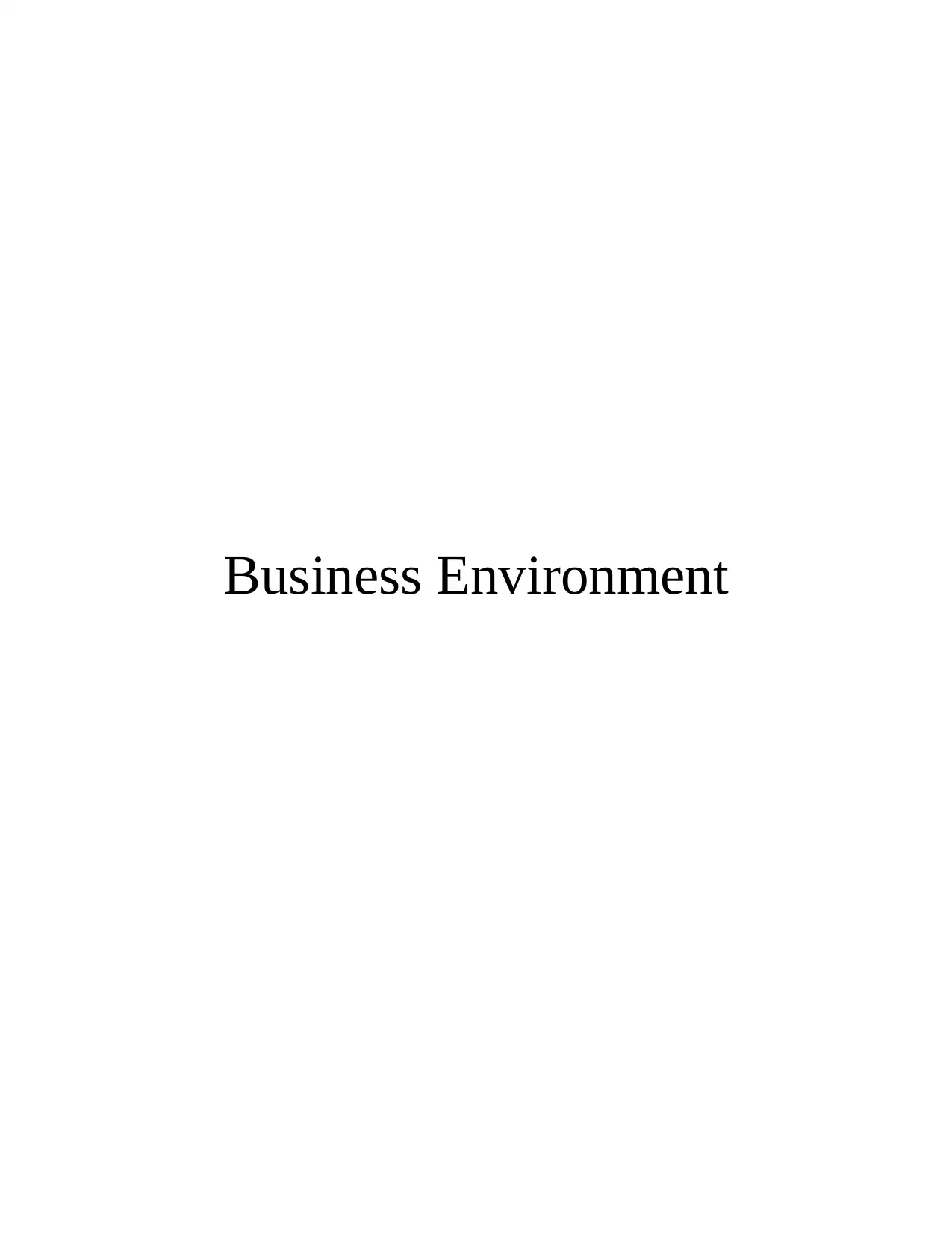
Business Environment
Paraphrase This Document
Need a fresh take? Get an instant paraphrase of this document with our AI Paraphraser
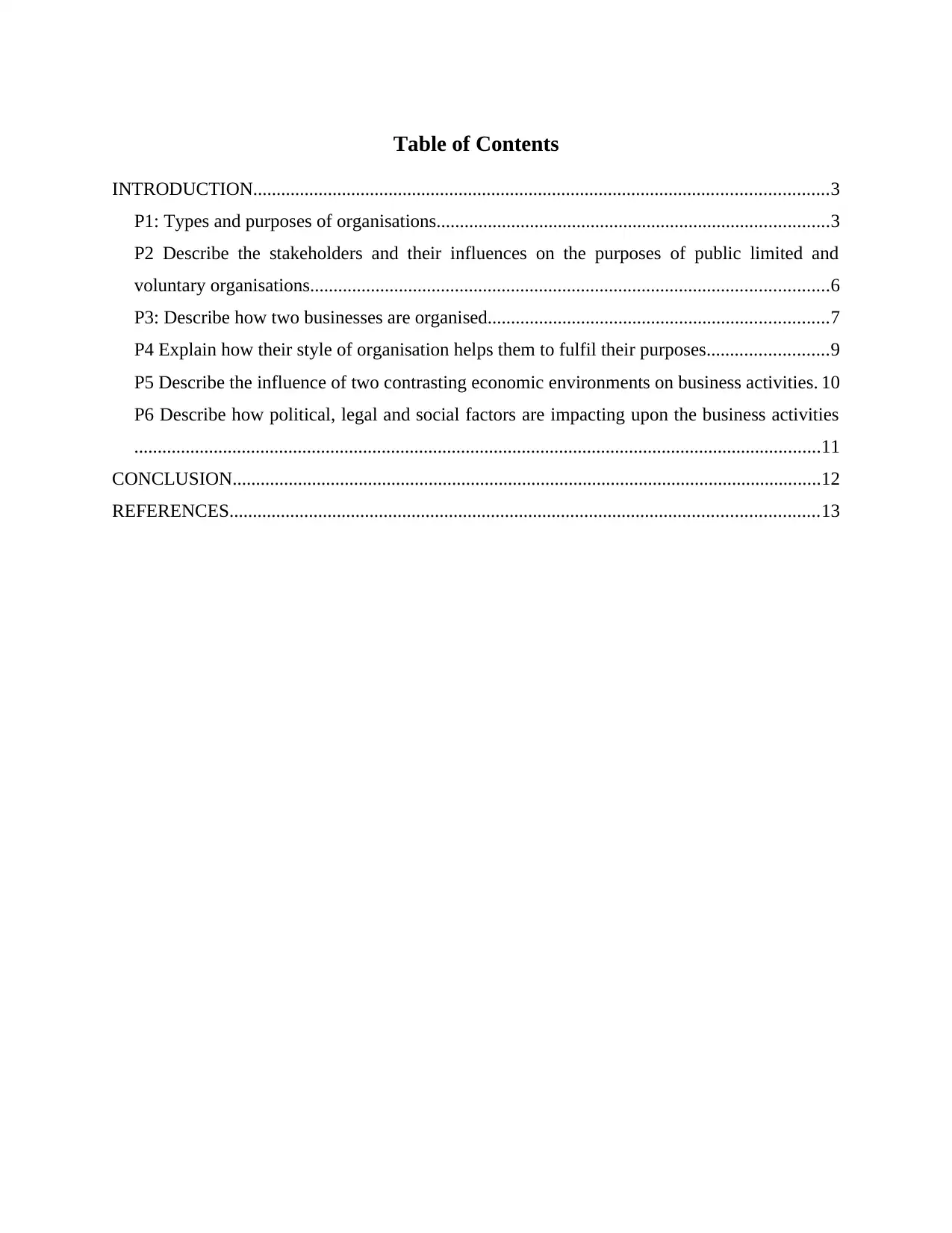
Table of Contents
INTRODUCTION...........................................................................................................................3
P1: Types and purposes of organisations....................................................................................3
P2 Describe the stakeholders and their influences on the purposes of public limited and
voluntary organisations...............................................................................................................6
P3: Describe how two businesses are organised.........................................................................7
P4 Explain how their style of organisation helps them to fulfil their purposes..........................9
P5 Describe the influence of two contrasting economic environments on business activities. 10
P6 Describe how political, legal and social factors are impacting upon the business activities
...................................................................................................................................................11
CONCLUSION..............................................................................................................................12
REFERENCES..............................................................................................................................13
INTRODUCTION...........................................................................................................................3
P1: Types and purposes of organisations....................................................................................3
P2 Describe the stakeholders and their influences on the purposes of public limited and
voluntary organisations...............................................................................................................6
P3: Describe how two businesses are organised.........................................................................7
P4 Explain how their style of organisation helps them to fulfil their purposes..........................9
P5 Describe the influence of two contrasting economic environments on business activities. 10
P6 Describe how political, legal and social factors are impacting upon the business activities
...................................................................................................................................................11
CONCLUSION..............................................................................................................................12
REFERENCES..............................................................................................................................13
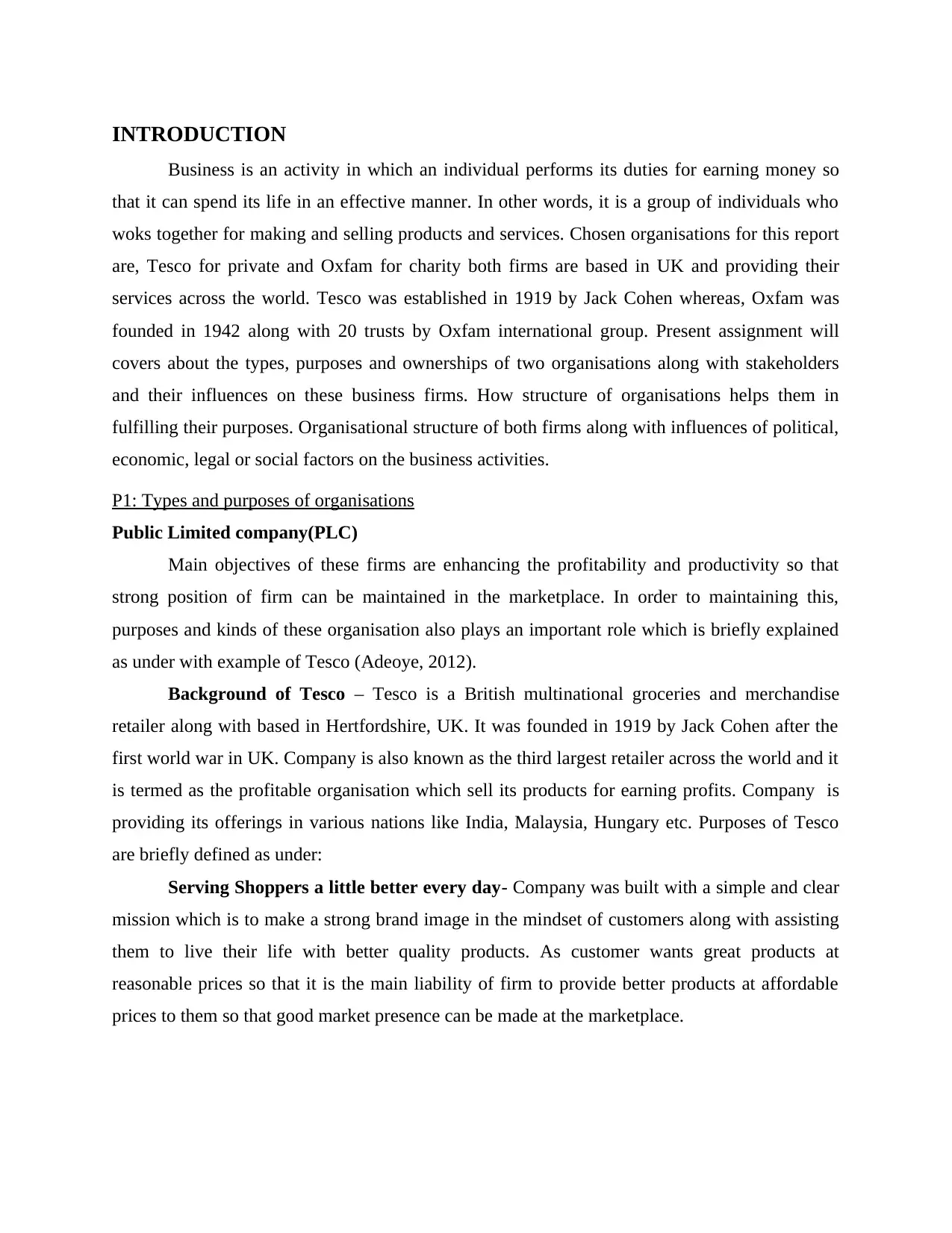
INTRODUCTION
Business is an activity in which an individual performs its duties for earning money so
that it can spend its life in an effective manner. In other words, it is a group of individuals who
woks together for making and selling products and services. Chosen organisations for this report
are, Tesco for private and Oxfam for charity both firms are based in UK and providing their
services across the world. Tesco was established in 1919 by Jack Cohen whereas, Oxfam was
founded in 1942 along with 20 trusts by Oxfam international group. Present assignment will
covers about the types, purposes and ownerships of two organisations along with stakeholders
and their influences on these business firms. How structure of organisations helps them in
fulfilling their purposes. Organisational structure of both firms along with influences of political,
economic, legal or social factors on the business activities.
P1: Types and purposes of organisations
Public Limited company(PLC)
Main objectives of these firms are enhancing the profitability and productivity so that
strong position of firm can be maintained in the marketplace. In order to maintaining this,
purposes and kinds of these organisation also plays an important role which is briefly explained
as under with example of Tesco (Adeoye, 2012).
Background of Tesco – Tesco is a British multinational groceries and merchandise
retailer along with based in Hertfordshire, UK. It was founded in 1919 by Jack Cohen after the
first world war in UK. Company is also known as the third largest retailer across the world and it
is termed as the profitable organisation which sell its products for earning profits. Company is
providing its offerings in various nations like India, Malaysia, Hungary etc. Purposes of Tesco
are briefly defined as under:
Serving Shoppers a little better every day- Company was built with a simple and clear
mission which is to make a strong brand image in the mindset of customers along with assisting
them to live their life with better quality products. As customer wants great products at
reasonable prices so that it is the main liability of firm to provide better products at affordable
prices to them so that good market presence can be made at the marketplace.
Business is an activity in which an individual performs its duties for earning money so
that it can spend its life in an effective manner. In other words, it is a group of individuals who
woks together for making and selling products and services. Chosen organisations for this report
are, Tesco for private and Oxfam for charity both firms are based in UK and providing their
services across the world. Tesco was established in 1919 by Jack Cohen whereas, Oxfam was
founded in 1942 along with 20 trusts by Oxfam international group. Present assignment will
covers about the types, purposes and ownerships of two organisations along with stakeholders
and their influences on these business firms. How structure of organisations helps them in
fulfilling their purposes. Organisational structure of both firms along with influences of political,
economic, legal or social factors on the business activities.
P1: Types and purposes of organisations
Public Limited company(PLC)
Main objectives of these firms are enhancing the profitability and productivity so that
strong position of firm can be maintained in the marketplace. In order to maintaining this,
purposes and kinds of these organisation also plays an important role which is briefly explained
as under with example of Tesco (Adeoye, 2012).
Background of Tesco – Tesco is a British multinational groceries and merchandise
retailer along with based in Hertfordshire, UK. It was founded in 1919 by Jack Cohen after the
first world war in UK. Company is also known as the third largest retailer across the world and it
is termed as the profitable organisation which sell its products for earning profits. Company is
providing its offerings in various nations like India, Malaysia, Hungary etc. Purposes of Tesco
are briefly defined as under:
Serving Shoppers a little better every day- Company was built with a simple and clear
mission which is to make a strong brand image in the mindset of customers along with assisting
them to live their life with better quality products. As customer wants great products at
reasonable prices so that it is the main liability of firm to provide better products at affordable
prices to them so that good market presence can be made at the marketplace.
⊘ This is a preview!⊘
Do you want full access?
Subscribe today to unlock all pages.

Trusted by 1+ million students worldwide
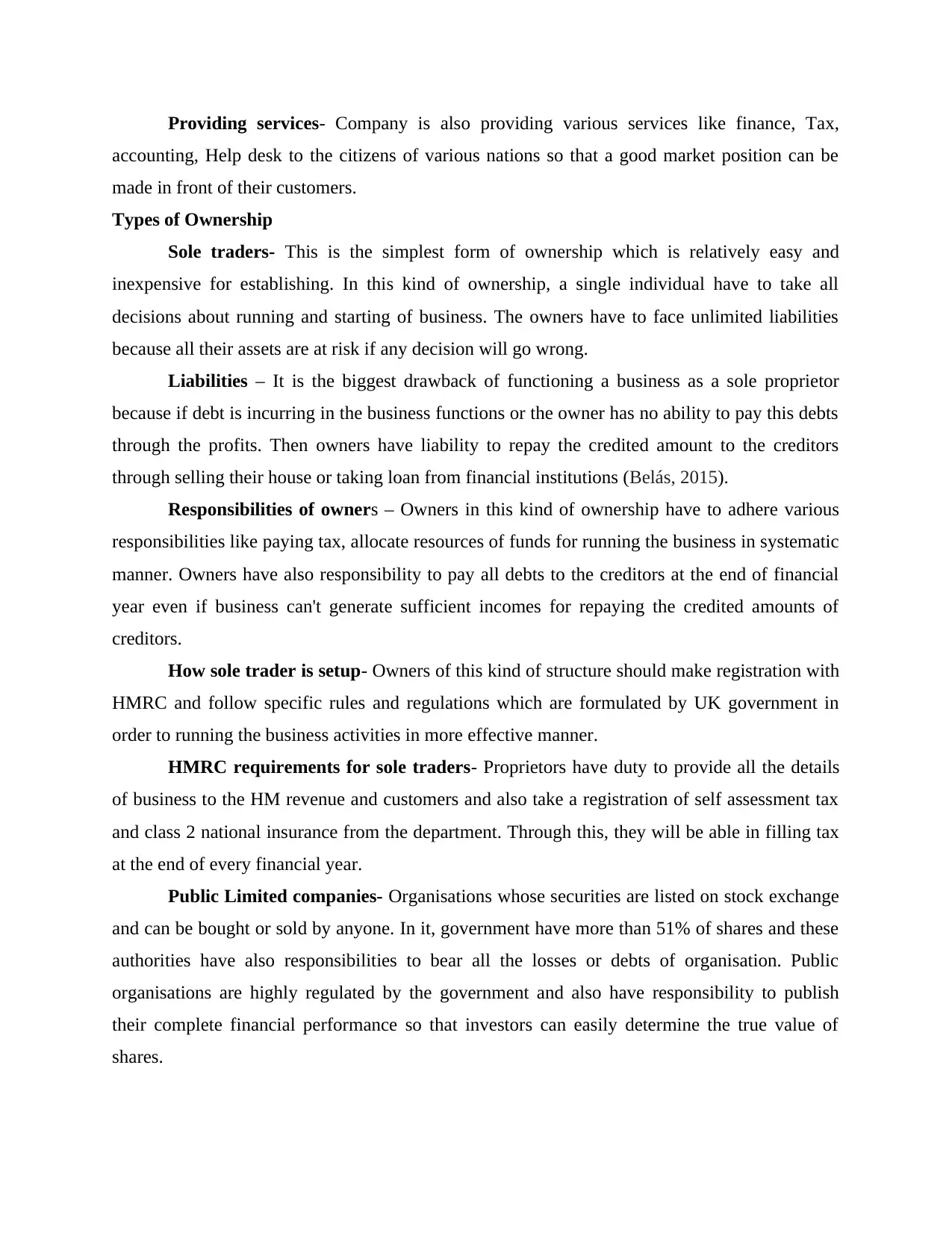
Providing services- Company is also providing various services like finance, Tax,
accounting, Help desk to the citizens of various nations so that a good market position can be
made in front of their customers.
Types of Ownership
Sole traders- This is the simplest form of ownership which is relatively easy and
inexpensive for establishing. In this kind of ownership, a single individual have to take all
decisions about running and starting of business. The owners have to face unlimited liabilities
because all their assets are at risk if any decision will go wrong.
Liabilities – It is the biggest drawback of functioning a business as a sole proprietor
because if debt is incurring in the business functions or the owner has no ability to pay this debts
through the profits. Then owners have liability to repay the credited amount to the creditors
through selling their house or taking loan from financial institutions (Belás, 2015).
Responsibilities of owners – Owners in this kind of ownership have to adhere various
responsibilities like paying tax, allocate resources of funds for running the business in systematic
manner. Owners have also responsibility to pay all debts to the creditors at the end of financial
year even if business can't generate sufficient incomes for repaying the credited amounts of
creditors.
How sole trader is setup- Owners of this kind of structure should make registration with
HMRC and follow specific rules and regulations which are formulated by UK government in
order to running the business activities in more effective manner.
HMRC requirements for sole traders- Proprietors have duty to provide all the details
of business to the HM revenue and customers and also take a registration of self assessment tax
and class 2 national insurance from the department. Through this, they will be able in filling tax
at the end of every financial year.
Public Limited companies- Organisations whose securities are listed on stock exchange
and can be bought or sold by anyone. In it, government have more than 51% of shares and these
authorities have also responsibilities to bear all the losses or debts of organisation. Public
organisations are highly regulated by the government and also have responsibility to publish
their complete financial performance so that investors can easily determine the true value of
shares.
accounting, Help desk to the citizens of various nations so that a good market position can be
made in front of their customers.
Types of Ownership
Sole traders- This is the simplest form of ownership which is relatively easy and
inexpensive for establishing. In this kind of ownership, a single individual have to take all
decisions about running and starting of business. The owners have to face unlimited liabilities
because all their assets are at risk if any decision will go wrong.
Liabilities – It is the biggest drawback of functioning a business as a sole proprietor
because if debt is incurring in the business functions or the owner has no ability to pay this debts
through the profits. Then owners have liability to repay the credited amount to the creditors
through selling their house or taking loan from financial institutions (Belás, 2015).
Responsibilities of owners – Owners in this kind of ownership have to adhere various
responsibilities like paying tax, allocate resources of funds for running the business in systematic
manner. Owners have also responsibility to pay all debts to the creditors at the end of financial
year even if business can't generate sufficient incomes for repaying the credited amounts of
creditors.
How sole trader is setup- Owners of this kind of structure should make registration with
HMRC and follow specific rules and regulations which are formulated by UK government in
order to running the business activities in more effective manner.
HMRC requirements for sole traders- Proprietors have duty to provide all the details
of business to the HM revenue and customers and also take a registration of self assessment tax
and class 2 national insurance from the department. Through this, they will be able in filling tax
at the end of every financial year.
Public Limited companies- Organisations whose securities are listed on stock exchange
and can be bought or sold by anyone. In it, government have more than 51% of shares and these
authorities have also responsibilities to bear all the losses or debts of organisation. Public
organisations are highly regulated by the government and also have responsibility to publish
their complete financial performance so that investors can easily determine the true value of
shares.
Paraphrase This Document
Need a fresh take? Get an instant paraphrase of this document with our AI Paraphraser
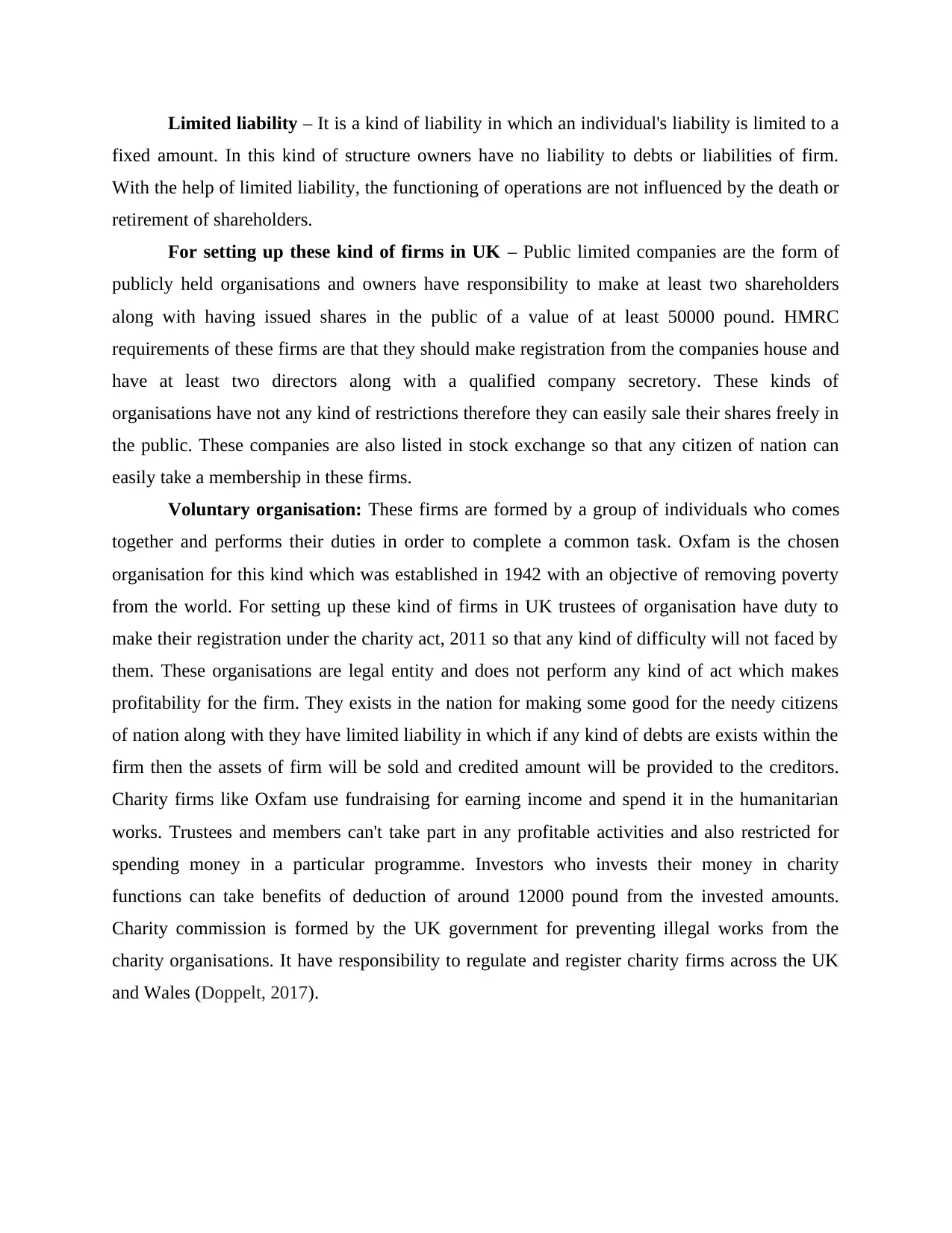
Limited liability – It is a kind of liability in which an individual's liability is limited to a
fixed amount. In this kind of structure owners have no liability to debts or liabilities of firm.
With the help of limited liability, the functioning of operations are not influenced by the death or
retirement of shareholders.
For setting up these kind of firms in UK – Public limited companies are the form of
publicly held organisations and owners have responsibility to make at least two shareholders
along with having issued shares in the public of a value of at least 50000 pound. HMRC
requirements of these firms are that they should make registration from the companies house and
have at least two directors along with a qualified company secretory. These kinds of
organisations have not any kind of restrictions therefore they can easily sale their shares freely in
the public. These companies are also listed in stock exchange so that any citizen of nation can
easily take a membership in these firms.
Voluntary organisation: These firms are formed by a group of individuals who comes
together and performs their duties in order to complete a common task. Oxfam is the chosen
organisation for this kind which was established in 1942 with an objective of removing poverty
from the world. For setting up these kind of firms in UK trustees of organisation have duty to
make their registration under the charity act, 2011 so that any kind of difficulty will not faced by
them. These organisations are legal entity and does not perform any kind of act which makes
profitability for the firm. They exists in the nation for making some good for the needy citizens
of nation along with they have limited liability in which if any kind of debts are exists within the
firm then the assets of firm will be sold and credited amount will be provided to the creditors.
Charity firms like Oxfam use fundraising for earning income and spend it in the humanitarian
works. Trustees and members can't take part in any profitable activities and also restricted for
spending money in a particular programme. Investors who invests their money in charity
functions can take benefits of deduction of around 12000 pound from the invested amounts.
Charity commission is formed by the UK government for preventing illegal works from the
charity organisations. It have responsibility to regulate and register charity firms across the UK
and Wales (Doppelt, 2017).
fixed amount. In this kind of structure owners have no liability to debts or liabilities of firm.
With the help of limited liability, the functioning of operations are not influenced by the death or
retirement of shareholders.
For setting up these kind of firms in UK – Public limited companies are the form of
publicly held organisations and owners have responsibility to make at least two shareholders
along with having issued shares in the public of a value of at least 50000 pound. HMRC
requirements of these firms are that they should make registration from the companies house and
have at least two directors along with a qualified company secretory. These kinds of
organisations have not any kind of restrictions therefore they can easily sale their shares freely in
the public. These companies are also listed in stock exchange so that any citizen of nation can
easily take a membership in these firms.
Voluntary organisation: These firms are formed by a group of individuals who comes
together and performs their duties in order to complete a common task. Oxfam is the chosen
organisation for this kind which was established in 1942 with an objective of removing poverty
from the world. For setting up these kind of firms in UK trustees of organisation have duty to
make their registration under the charity act, 2011 so that any kind of difficulty will not faced by
them. These organisations are legal entity and does not perform any kind of act which makes
profitability for the firm. They exists in the nation for making some good for the needy citizens
of nation along with they have limited liability in which if any kind of debts are exists within the
firm then the assets of firm will be sold and credited amount will be provided to the creditors.
Charity firms like Oxfam use fundraising for earning income and spend it in the humanitarian
works. Trustees and members can't take part in any profitable activities and also restricted for
spending money in a particular programme. Investors who invests their money in charity
functions can take benefits of deduction of around 12000 pound from the invested amounts.
Charity commission is formed by the UK government for preventing illegal works from the
charity organisations. It have responsibility to regulate and register charity firms across the UK
and Wales (Doppelt, 2017).
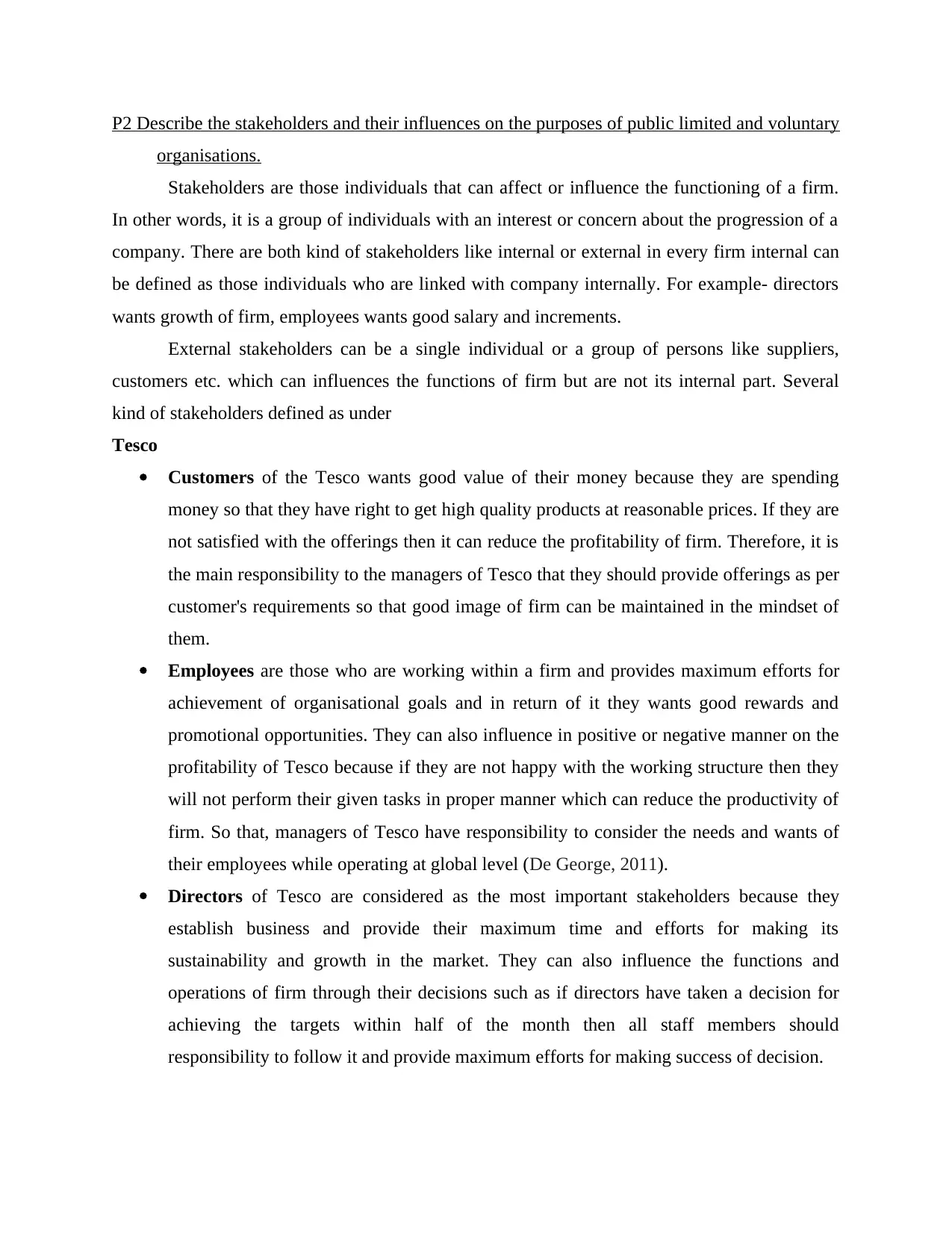
P2 Describe the stakeholders and their influences on the purposes of public limited and voluntary
organisations.
Stakeholders are those individuals that can affect or influence the functioning of a firm.
In other words, it is a group of individuals with an interest or concern about the progression of a
company. There are both kind of stakeholders like internal or external in every firm internal can
be defined as those individuals who are linked with company internally. For example- directors
wants growth of firm, employees wants good salary and increments.
External stakeholders can be a single individual or a group of persons like suppliers,
customers etc. which can influences the functions of firm but are not its internal part. Several
kind of stakeholders defined as under
Tesco
Customers of the Tesco wants good value of their money because they are spending
money so that they have right to get high quality products at reasonable prices. If they are
not satisfied with the offerings then it can reduce the profitability of firm. Therefore, it is
the main responsibility to the managers of Tesco that they should provide offerings as per
customer's requirements so that good image of firm can be maintained in the mindset of
them.
Employees are those who are working within a firm and provides maximum efforts for
achievement of organisational goals and in return of it they wants good rewards and
promotional opportunities. They can also influence in positive or negative manner on the
profitability of Tesco because if they are not happy with the working structure then they
will not perform their given tasks in proper manner which can reduce the productivity of
firm. So that, managers of Tesco have responsibility to consider the needs and wants of
their employees while operating at global level (De George, 2011).
Directors of Tesco are considered as the most important stakeholders because they
establish business and provide their maximum time and efforts for making its
sustainability and growth in the market. They can also influence the functions and
operations of firm through their decisions such as if directors have taken a decision for
achieving the targets within half of the month then all staff members should
responsibility to follow it and provide maximum efforts for making success of decision.
organisations.
Stakeholders are those individuals that can affect or influence the functioning of a firm.
In other words, it is a group of individuals with an interest or concern about the progression of a
company. There are both kind of stakeholders like internal or external in every firm internal can
be defined as those individuals who are linked with company internally. For example- directors
wants growth of firm, employees wants good salary and increments.
External stakeholders can be a single individual or a group of persons like suppliers,
customers etc. which can influences the functions of firm but are not its internal part. Several
kind of stakeholders defined as under
Tesco
Customers of the Tesco wants good value of their money because they are spending
money so that they have right to get high quality products at reasonable prices. If they are
not satisfied with the offerings then it can reduce the profitability of firm. Therefore, it is
the main responsibility to the managers of Tesco that they should provide offerings as per
customer's requirements so that good image of firm can be maintained in the mindset of
them.
Employees are those who are working within a firm and provides maximum efforts for
achievement of organisational goals and in return of it they wants good rewards and
promotional opportunities. They can also influence in positive or negative manner on the
profitability of Tesco because if they are not happy with the working structure then they
will not perform their given tasks in proper manner which can reduce the productivity of
firm. So that, managers of Tesco have responsibility to consider the needs and wants of
their employees while operating at global level (De George, 2011).
Directors of Tesco are considered as the most important stakeholders because they
establish business and provide their maximum time and efforts for making its
sustainability and growth in the market. They can also influence the functions and
operations of firm through their decisions such as if directors have taken a decision for
achieving the targets within half of the month then all staff members should
responsibility to follow it and provide maximum efforts for making success of decision.
⊘ This is a preview!⊘
Do you want full access?
Subscribe today to unlock all pages.

Trusted by 1+ million students worldwide
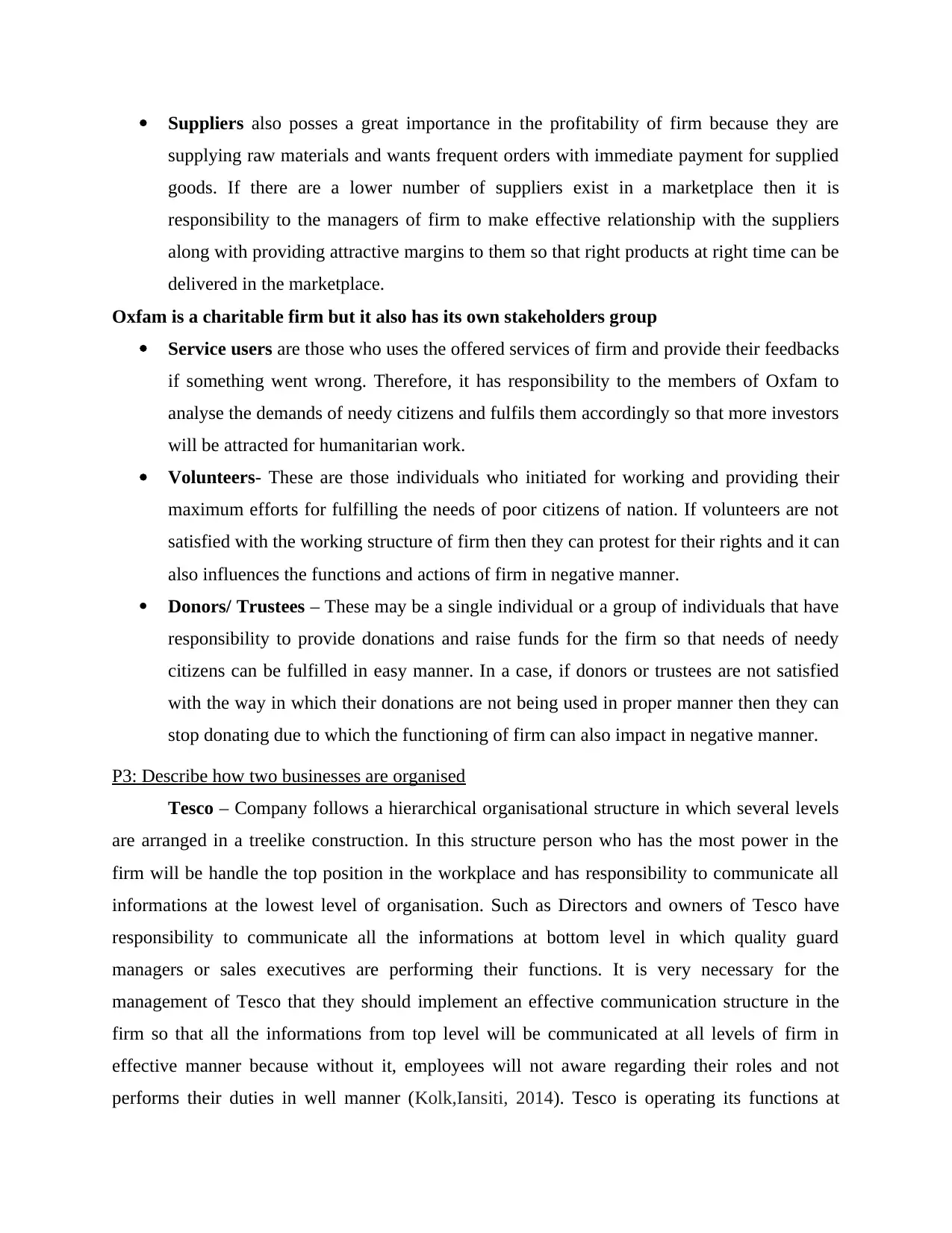
Suppliers also posses a great importance in the profitability of firm because they are
supplying raw materials and wants frequent orders with immediate payment for supplied
goods. If there are a lower number of suppliers exist in a marketplace then it is
responsibility to the managers of firm to make effective relationship with the suppliers
along with providing attractive margins to them so that right products at right time can be
delivered in the marketplace.
Oxfam is a charitable firm but it also has its own stakeholders group
Service users are those who uses the offered services of firm and provide their feedbacks
if something went wrong. Therefore, it has responsibility to the members of Oxfam to
analyse the demands of needy citizens and fulfils them accordingly so that more investors
will be attracted for humanitarian work.
Volunteers- These are those individuals who initiated for working and providing their
maximum efforts for fulfilling the needs of poor citizens of nation. If volunteers are not
satisfied with the working structure of firm then they can protest for their rights and it can
also influences the functions and actions of firm in negative manner.
Donors/ Trustees – These may be a single individual or a group of individuals that have
responsibility to provide donations and raise funds for the firm so that needs of needy
citizens can be fulfilled in easy manner. In a case, if donors or trustees are not satisfied
with the way in which their donations are not being used in proper manner then they can
stop donating due to which the functioning of firm can also impact in negative manner.
P3: Describe how two businesses are organised
Tesco – Company follows a hierarchical organisational structure in which several levels
are arranged in a treelike construction. In this structure person who has the most power in the
firm will be handle the top position in the workplace and has responsibility to communicate all
informations at the lowest level of organisation. Such as Directors and owners of Tesco have
responsibility to communicate all the informations at bottom level in which quality guard
managers or sales executives are performing their functions. It is very necessary for the
management of Tesco that they should implement an effective communication structure in the
firm so that all the informations from top level will be communicated at all levels of firm in
effective manner because without it, employees will not aware regarding their roles and not
performs their duties in well manner (Kolk,Iansiti, 2014). Tesco is operating its functions at
supplying raw materials and wants frequent orders with immediate payment for supplied
goods. If there are a lower number of suppliers exist in a marketplace then it is
responsibility to the managers of firm to make effective relationship with the suppliers
along with providing attractive margins to them so that right products at right time can be
delivered in the marketplace.
Oxfam is a charitable firm but it also has its own stakeholders group
Service users are those who uses the offered services of firm and provide their feedbacks
if something went wrong. Therefore, it has responsibility to the members of Oxfam to
analyse the demands of needy citizens and fulfils them accordingly so that more investors
will be attracted for humanitarian work.
Volunteers- These are those individuals who initiated for working and providing their
maximum efforts for fulfilling the needs of poor citizens of nation. If volunteers are not
satisfied with the working structure of firm then they can protest for their rights and it can
also influences the functions and actions of firm in negative manner.
Donors/ Trustees – These may be a single individual or a group of individuals that have
responsibility to provide donations and raise funds for the firm so that needs of needy
citizens can be fulfilled in easy manner. In a case, if donors or trustees are not satisfied
with the way in which their donations are not being used in proper manner then they can
stop donating due to which the functioning of firm can also impact in negative manner.
P3: Describe how two businesses are organised
Tesco – Company follows a hierarchical organisational structure in which several levels
are arranged in a treelike construction. In this structure person who has the most power in the
firm will be handle the top position in the workplace and has responsibility to communicate all
informations at the lowest level of organisation. Such as Directors and owners of Tesco have
responsibility to communicate all the informations at bottom level in which quality guard
managers or sales executives are performing their functions. It is very necessary for the
management of Tesco that they should implement an effective communication structure in the
firm so that all the informations from top level will be communicated at all levels of firm in
effective manner because without it, employees will not aware regarding their roles and not
performs their duties in well manner (Kolk,Iansiti, 2014). Tesco is operating its functions at
Paraphrase This Document
Need a fresh take? Get an instant paraphrase of this document with our AI Paraphraser
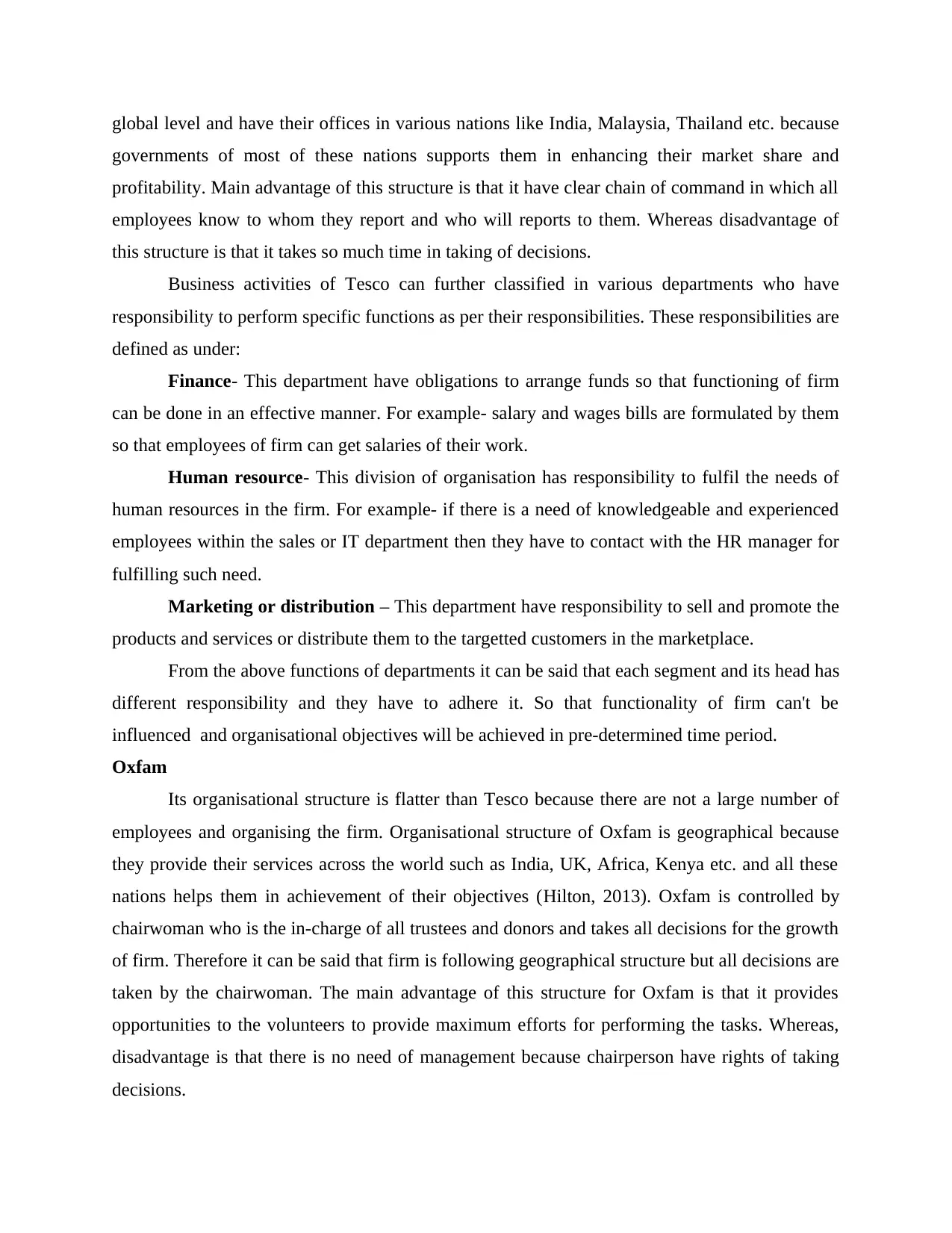
global level and have their offices in various nations like India, Malaysia, Thailand etc. because
governments of most of these nations supports them in enhancing their market share and
profitability. Main advantage of this structure is that it have clear chain of command in which all
employees know to whom they report and who will reports to them. Whereas disadvantage of
this structure is that it takes so much time in taking of decisions.
Business activities of Tesco can further classified in various departments who have
responsibility to perform specific functions as per their responsibilities. These responsibilities are
defined as under:
Finance- This department have obligations to arrange funds so that functioning of firm
can be done in an effective manner. For example- salary and wages bills are formulated by them
so that employees of firm can get salaries of their work.
Human resource- This division of organisation has responsibility to fulfil the needs of
human resources in the firm. For example- if there is a need of knowledgeable and experienced
employees within the sales or IT department then they have to contact with the HR manager for
fulfilling such need.
Marketing or distribution – This department have responsibility to sell and promote the
products and services or distribute them to the targetted customers in the marketplace.
From the above functions of departments it can be said that each segment and its head has
different responsibility and they have to adhere it. So that functionality of firm can't be
influenced and organisational objectives will be achieved in pre-determined time period.
Oxfam
Its organisational structure is flatter than Tesco because there are not a large number of
employees and organising the firm. Organisational structure of Oxfam is geographical because
they provide their services across the world such as India, UK, Africa, Kenya etc. and all these
nations helps them in achievement of their objectives (Hilton, 2013). Oxfam is controlled by
chairwoman who is the in-charge of all trustees and donors and takes all decisions for the growth
of firm. Therefore it can be said that firm is following geographical structure but all decisions are
taken by the chairwoman. The main advantage of this structure for Oxfam is that it provides
opportunities to the volunteers to provide maximum efforts for performing the tasks. Whereas,
disadvantage is that there is no need of management because chairperson have rights of taking
decisions.
governments of most of these nations supports them in enhancing their market share and
profitability. Main advantage of this structure is that it have clear chain of command in which all
employees know to whom they report and who will reports to them. Whereas disadvantage of
this structure is that it takes so much time in taking of decisions.
Business activities of Tesco can further classified in various departments who have
responsibility to perform specific functions as per their responsibilities. These responsibilities are
defined as under:
Finance- This department have obligations to arrange funds so that functioning of firm
can be done in an effective manner. For example- salary and wages bills are formulated by them
so that employees of firm can get salaries of their work.
Human resource- This division of organisation has responsibility to fulfil the needs of
human resources in the firm. For example- if there is a need of knowledgeable and experienced
employees within the sales or IT department then they have to contact with the HR manager for
fulfilling such need.
Marketing or distribution – This department have responsibility to sell and promote the
products and services or distribute them to the targetted customers in the marketplace.
From the above functions of departments it can be said that each segment and its head has
different responsibility and they have to adhere it. So that functionality of firm can't be
influenced and organisational objectives will be achieved in pre-determined time period.
Oxfam
Its organisational structure is flatter than Tesco because there are not a large number of
employees and organising the firm. Organisational structure of Oxfam is geographical because
they provide their services across the world such as India, UK, Africa, Kenya etc. and all these
nations helps them in achievement of their objectives (Hilton, 2013). Oxfam is controlled by
chairwoman who is the in-charge of all trustees and donors and takes all decisions for the growth
of firm. Therefore it can be said that firm is following geographical structure but all decisions are
taken by the chairwoman. The main advantage of this structure for Oxfam is that it provides
opportunities to the volunteers to provide maximum efforts for performing the tasks. Whereas,
disadvantage is that there is no need of management because chairperson have rights of taking
decisions.
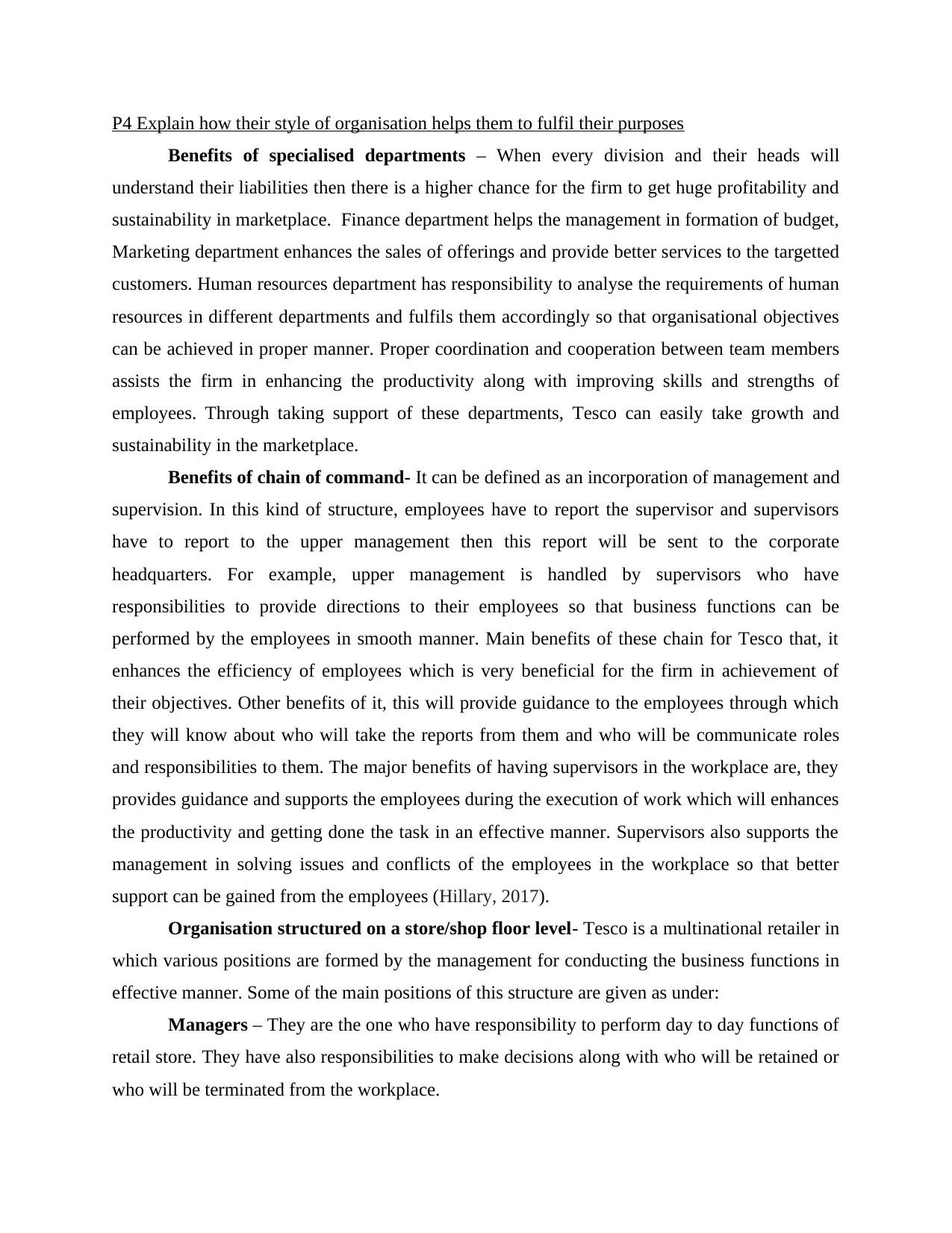
P4 Explain how their style of organisation helps them to fulfil their purposes
Benefits of specialised departments – When every division and their heads will
understand their liabilities then there is a higher chance for the firm to get huge profitability and
sustainability in marketplace. Finance department helps the management in formation of budget,
Marketing department enhances the sales of offerings and provide better services to the targetted
customers. Human resources department has responsibility to analyse the requirements of human
resources in different departments and fulfils them accordingly so that organisational objectives
can be achieved in proper manner. Proper coordination and cooperation between team members
assists the firm in enhancing the productivity along with improving skills and strengths of
employees. Through taking support of these departments, Tesco can easily take growth and
sustainability in the marketplace.
Benefits of chain of command- It can be defined as an incorporation of management and
supervision. In this kind of structure, employees have to report the supervisor and supervisors
have to report to the upper management then this report will be sent to the corporate
headquarters. For example, upper management is handled by supervisors who have
responsibilities to provide directions to their employees so that business functions can be
performed by the employees in smooth manner. Main benefits of these chain for Tesco that, it
enhances the efficiency of employees which is very beneficial for the firm in achievement of
their objectives. Other benefits of it, this will provide guidance to the employees through which
they will know about who will take the reports from them and who will be communicate roles
and responsibilities to them. The major benefits of having supervisors in the workplace are, they
provides guidance and supports the employees during the execution of work which will enhances
the productivity and getting done the task in an effective manner. Supervisors also supports the
management in solving issues and conflicts of the employees in the workplace so that better
support can be gained from the employees (Hillary, 2017).
Organisation structured on a store/shop floor level- Tesco is a multinational retailer in
which various positions are formed by the management for conducting the business functions in
effective manner. Some of the main positions of this structure are given as under:
Managers – They are the one who have responsibility to perform day to day functions of
retail store. They have also responsibilities to make decisions along with who will be retained or
who will be terminated from the workplace.
Benefits of specialised departments – When every division and their heads will
understand their liabilities then there is a higher chance for the firm to get huge profitability and
sustainability in marketplace. Finance department helps the management in formation of budget,
Marketing department enhances the sales of offerings and provide better services to the targetted
customers. Human resources department has responsibility to analyse the requirements of human
resources in different departments and fulfils them accordingly so that organisational objectives
can be achieved in proper manner. Proper coordination and cooperation between team members
assists the firm in enhancing the productivity along with improving skills and strengths of
employees. Through taking support of these departments, Tesco can easily take growth and
sustainability in the marketplace.
Benefits of chain of command- It can be defined as an incorporation of management and
supervision. In this kind of structure, employees have to report the supervisor and supervisors
have to report to the upper management then this report will be sent to the corporate
headquarters. For example, upper management is handled by supervisors who have
responsibilities to provide directions to their employees so that business functions can be
performed by the employees in smooth manner. Main benefits of these chain for Tesco that, it
enhances the efficiency of employees which is very beneficial for the firm in achievement of
their objectives. Other benefits of it, this will provide guidance to the employees through which
they will know about who will take the reports from them and who will be communicate roles
and responsibilities to them. The major benefits of having supervisors in the workplace are, they
provides guidance and supports the employees during the execution of work which will enhances
the productivity and getting done the task in an effective manner. Supervisors also supports the
management in solving issues and conflicts of the employees in the workplace so that better
support can be gained from the employees (Hillary, 2017).
Organisation structured on a store/shop floor level- Tesco is a multinational retailer in
which various positions are formed by the management for conducting the business functions in
effective manner. Some of the main positions of this structure are given as under:
Managers – They are the one who have responsibility to perform day to day functions of
retail store. They have also responsibilities to make decisions along with who will be retained or
who will be terminated from the workplace.
⊘ This is a preview!⊘
Do you want full access?
Subscribe today to unlock all pages.

Trusted by 1+ million students worldwide
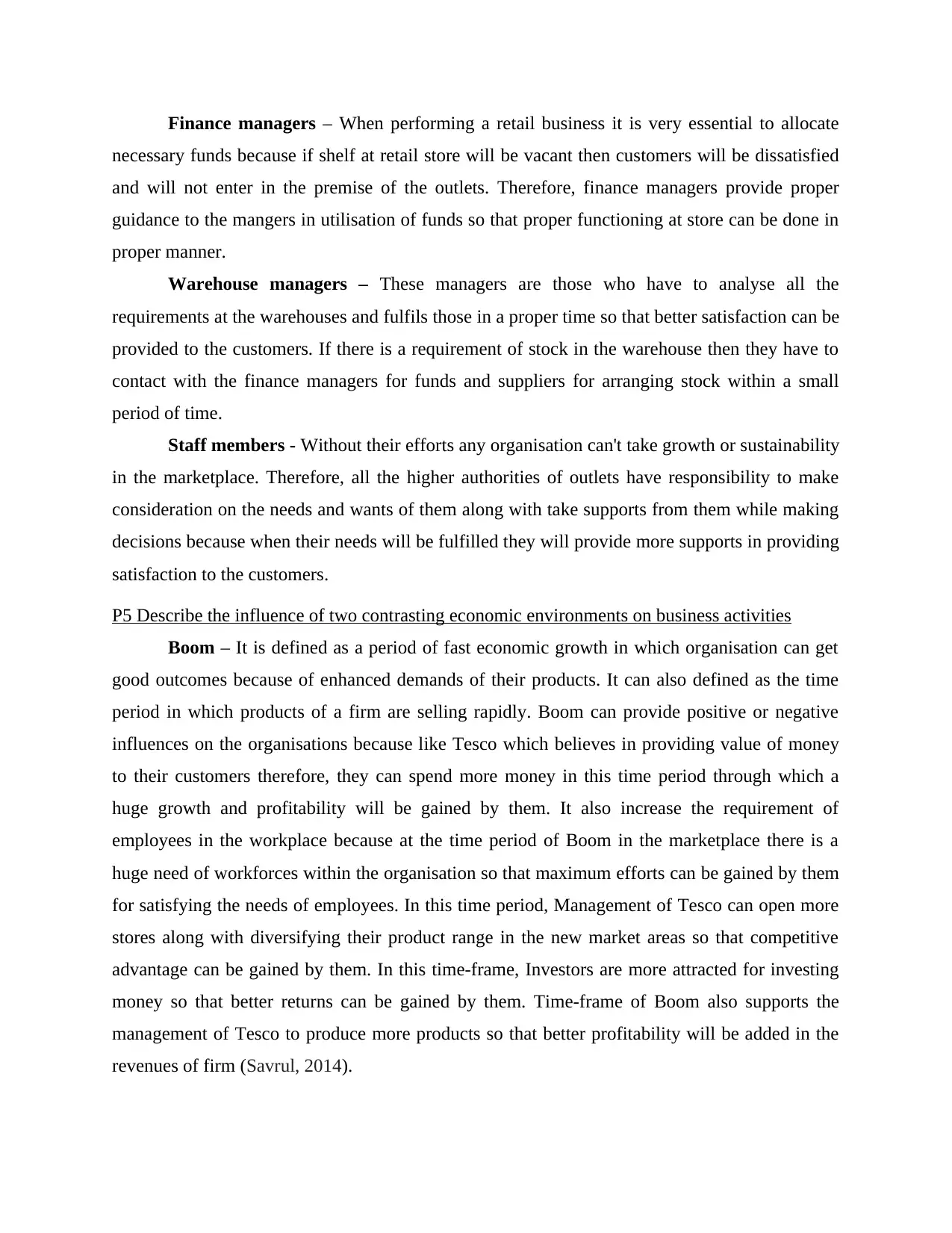
Finance managers – When performing a retail business it is very essential to allocate
necessary funds because if shelf at retail store will be vacant then customers will be dissatisfied
and will not enter in the premise of the outlets. Therefore, finance managers provide proper
guidance to the mangers in utilisation of funds so that proper functioning at store can be done in
proper manner.
Warehouse managers – These managers are those who have to analyse all the
requirements at the warehouses and fulfils those in a proper time so that better satisfaction can be
provided to the customers. If there is a requirement of stock in the warehouse then they have to
contact with the finance managers for funds and suppliers for arranging stock within a small
period of time.
Staff members - Without their efforts any organisation can't take growth or sustainability
in the marketplace. Therefore, all the higher authorities of outlets have responsibility to make
consideration on the needs and wants of them along with take supports from them while making
decisions because when their needs will be fulfilled they will provide more supports in providing
satisfaction to the customers.
P5 Describe the influence of two contrasting economic environments on business activities
Boom – It is defined as a period of fast economic growth in which organisation can get
good outcomes because of enhanced demands of their products. It can also defined as the time
period in which products of a firm are selling rapidly. Boom can provide positive or negative
influences on the organisations because like Tesco which believes in providing value of money
to their customers therefore, they can spend more money in this time period through which a
huge growth and profitability will be gained by them. It also increase the requirement of
employees in the workplace because at the time period of Boom in the marketplace there is a
huge need of workforces within the organisation so that maximum efforts can be gained by them
for satisfying the needs of employees. In this time period, Management of Tesco can open more
stores along with diversifying their product range in the new market areas so that competitive
advantage can be gained by them. In this time-frame, Investors are more attracted for investing
money so that better returns can be gained by them. Time-frame of Boom also supports the
management of Tesco to produce more products so that better profitability will be added in the
revenues of firm (Savrul, 2014).
necessary funds because if shelf at retail store will be vacant then customers will be dissatisfied
and will not enter in the premise of the outlets. Therefore, finance managers provide proper
guidance to the mangers in utilisation of funds so that proper functioning at store can be done in
proper manner.
Warehouse managers – These managers are those who have to analyse all the
requirements at the warehouses and fulfils those in a proper time so that better satisfaction can be
provided to the customers. If there is a requirement of stock in the warehouse then they have to
contact with the finance managers for funds and suppliers for arranging stock within a small
period of time.
Staff members - Without their efforts any organisation can't take growth or sustainability
in the marketplace. Therefore, all the higher authorities of outlets have responsibility to make
consideration on the needs and wants of them along with take supports from them while making
decisions because when their needs will be fulfilled they will provide more supports in providing
satisfaction to the customers.
P5 Describe the influence of two contrasting economic environments on business activities
Boom – It is defined as a period of fast economic growth in which organisation can get
good outcomes because of enhanced demands of their products. It can also defined as the time
period in which products of a firm are selling rapidly. Boom can provide positive or negative
influences on the organisations because like Tesco which believes in providing value of money
to their customers therefore, they can spend more money in this time period through which a
huge growth and profitability will be gained by them. It also increase the requirement of
employees in the workplace because at the time period of Boom in the marketplace there is a
huge need of workforces within the organisation so that maximum efforts can be gained by them
for satisfying the needs of employees. In this time period, Management of Tesco can open more
stores along with diversifying their product range in the new market areas so that competitive
advantage can be gained by them. In this time-frame, Investors are more attracted for investing
money so that better returns can be gained by them. Time-frame of Boom also supports the
management of Tesco to produce more products so that better profitability will be added in the
revenues of firm (Savrul, 2014).
Paraphrase This Document
Need a fresh take? Get an instant paraphrase of this document with our AI Paraphraser
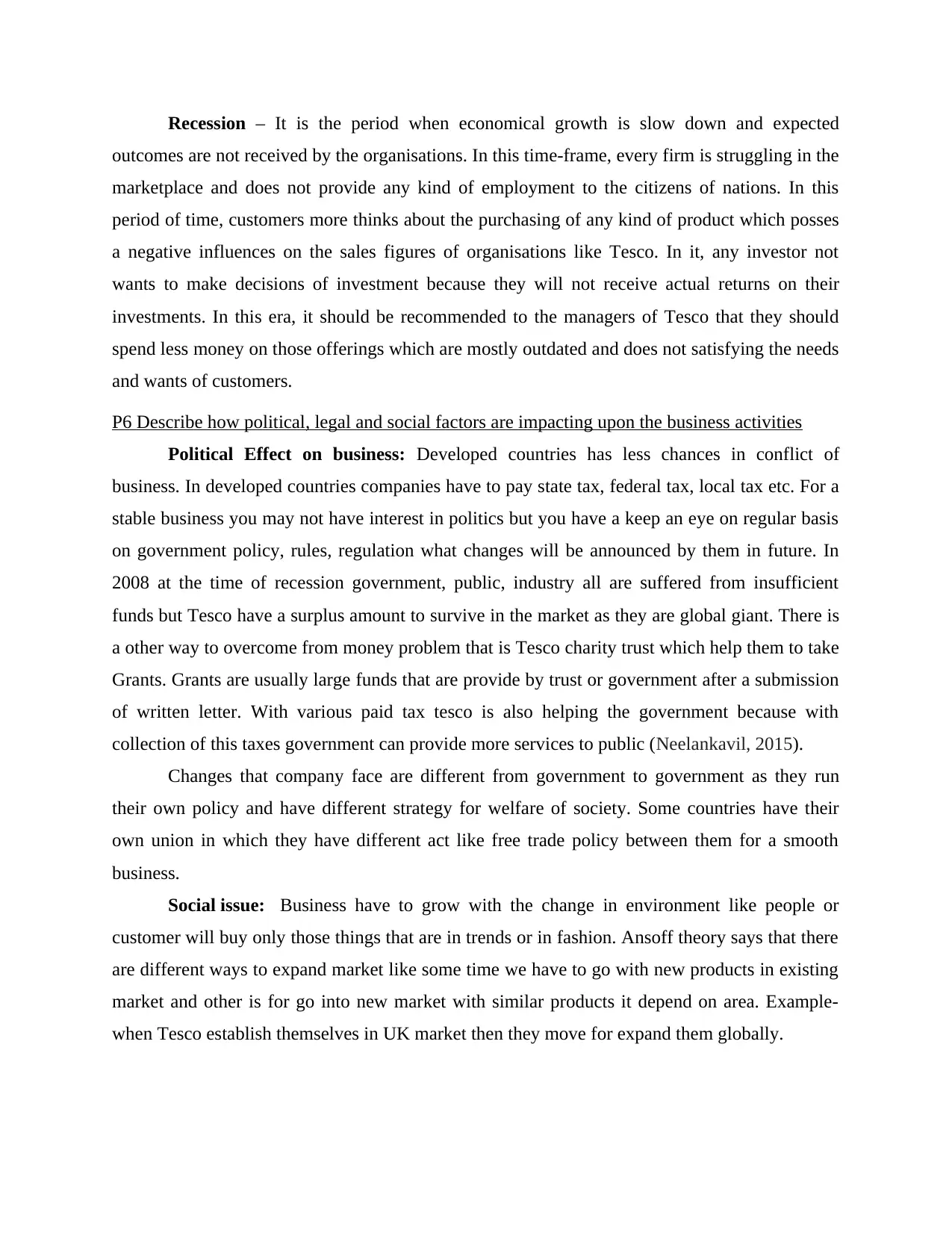
Recession – It is the period when economical growth is slow down and expected
outcomes are not received by the organisations. In this time-frame, every firm is struggling in the
marketplace and does not provide any kind of employment to the citizens of nations. In this
period of time, customers more thinks about the purchasing of any kind of product which posses
a negative influences on the sales figures of organisations like Tesco. In it, any investor not
wants to make decisions of investment because they will not receive actual returns on their
investments. In this era, it should be recommended to the managers of Tesco that they should
spend less money on those offerings which are mostly outdated and does not satisfying the needs
and wants of customers.
P6 Describe how political, legal and social factors are impacting upon the business activities
Political Effect on business: Developed countries has less chances in conflict of
business. In developed countries companies have to pay state tax, federal tax, local tax etc. For a
stable business you may not have interest in politics but you have a keep an eye on regular basis
on government policy, rules, regulation what changes will be announced by them in future. In
2008 at the time of recession government, public, industry all are suffered from insufficient
funds but Tesco have a surplus amount to survive in the market as they are global giant. There is
a other way to overcome from money problem that is Tesco charity trust which help them to take
Grants. Grants are usually large funds that are provide by trust or government after a submission
of written letter. With various paid tax tesco is also helping the government because with
collection of this taxes government can provide more services to public (Neelankavil, 2015).
Changes that company face are different from government to government as they run
their own policy and have different strategy for welfare of society. Some countries have their
own union in which they have different act like free trade policy between them for a smooth
business.
Social issue: Business have to grow with the change in environment like people or
customer will buy only those things that are in trends or in fashion. Ansoff theory says that there
are different ways to expand market like some time we have to go with new products in existing
market and other is for go into new market with similar products it depend on area. Example-
when Tesco establish themselves in UK market then they move for expand them globally.
outcomes are not received by the organisations. In this time-frame, every firm is struggling in the
marketplace and does not provide any kind of employment to the citizens of nations. In this
period of time, customers more thinks about the purchasing of any kind of product which posses
a negative influences on the sales figures of organisations like Tesco. In it, any investor not
wants to make decisions of investment because they will not receive actual returns on their
investments. In this era, it should be recommended to the managers of Tesco that they should
spend less money on those offerings which are mostly outdated and does not satisfying the needs
and wants of customers.
P6 Describe how political, legal and social factors are impacting upon the business activities
Political Effect on business: Developed countries has less chances in conflict of
business. In developed countries companies have to pay state tax, federal tax, local tax etc. For a
stable business you may not have interest in politics but you have a keep an eye on regular basis
on government policy, rules, regulation what changes will be announced by them in future. In
2008 at the time of recession government, public, industry all are suffered from insufficient
funds but Tesco have a surplus amount to survive in the market as they are global giant. There is
a other way to overcome from money problem that is Tesco charity trust which help them to take
Grants. Grants are usually large funds that are provide by trust or government after a submission
of written letter. With various paid tax tesco is also helping the government because with
collection of this taxes government can provide more services to public (Neelankavil, 2015).
Changes that company face are different from government to government as they run
their own policy and have different strategy for welfare of society. Some countries have their
own union in which they have different act like free trade policy between them for a smooth
business.
Social issue: Business have to grow with the change in environment like people or
customer will buy only those things that are in trends or in fashion. Ansoff theory says that there
are different ways to expand market like some time we have to go with new products in existing
market and other is for go into new market with similar products it depend on area. Example-
when Tesco establish themselves in UK market then they move for expand them globally.
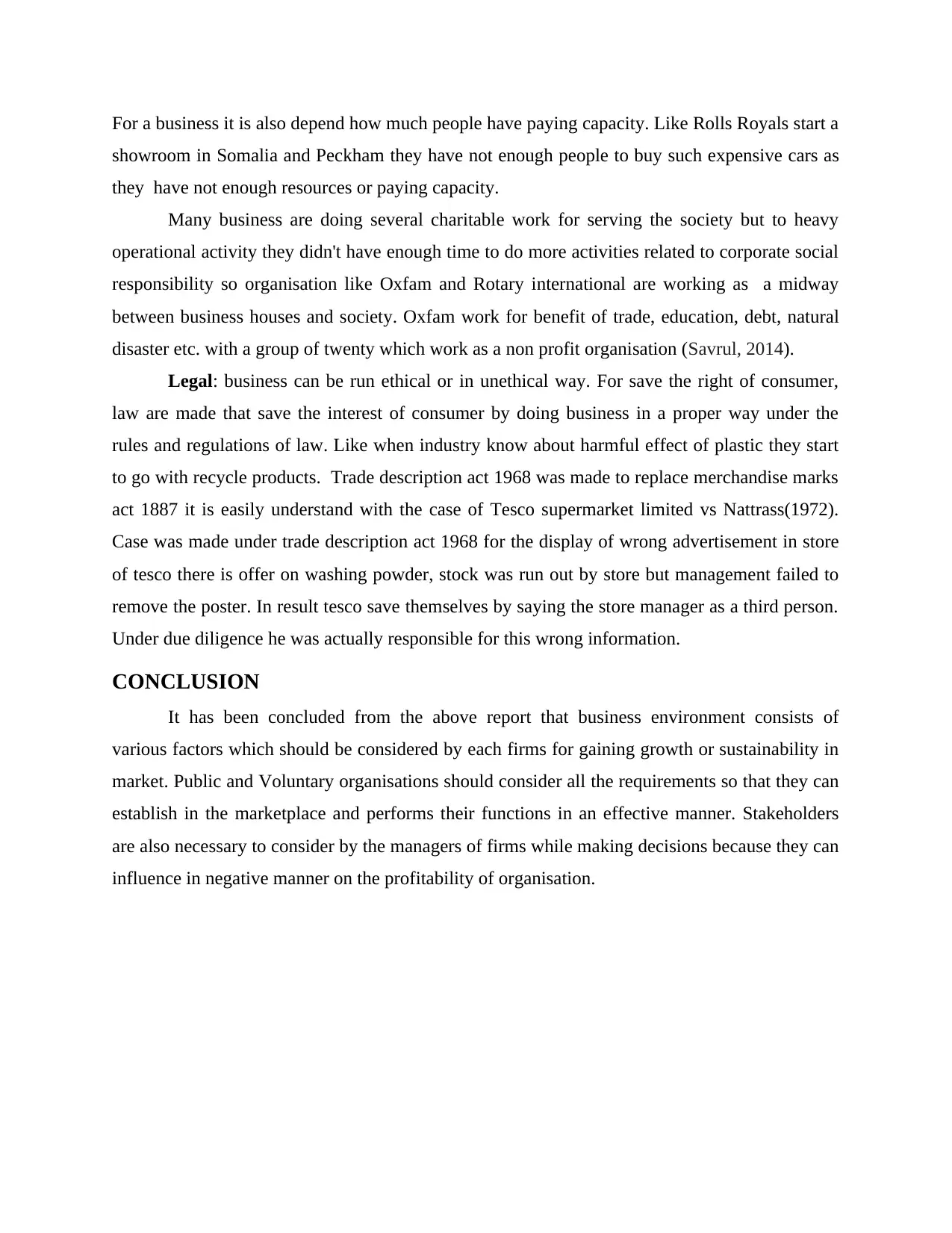
For a business it is also depend how much people have paying capacity. Like Rolls Royals start a
showroom in Somalia and Peckham they have not enough people to buy such expensive cars as
they have not enough resources or paying capacity.
Many business are doing several charitable work for serving the society but to heavy
operational activity they didn't have enough time to do more activities related to corporate social
responsibility so organisation like Oxfam and Rotary international are working as a midway
between business houses and society. Oxfam work for benefit of trade, education, debt, natural
disaster etc. with a group of twenty which work as a non profit organisation (Savrul, 2014).
Legal: business can be run ethical or in unethical way. For save the right of consumer,
law are made that save the interest of consumer by doing business in a proper way under the
rules and regulations of law. Like when industry know about harmful effect of plastic they start
to go with recycle products. Trade description act 1968 was made to replace merchandise marks
act 1887 it is easily understand with the case of Tesco supermarket limited vs Nattrass(1972).
Case was made under trade description act 1968 for the display of wrong advertisement in store
of tesco there is offer on washing powder, stock was run out by store but management failed to
remove the poster. In result tesco save themselves by saying the store manager as a third person.
Under due diligence he was actually responsible for this wrong information.
CONCLUSION
It has been concluded from the above report that business environment consists of
various factors which should be considered by each firms for gaining growth or sustainability in
market. Public and Voluntary organisations should consider all the requirements so that they can
establish in the marketplace and performs their functions in an effective manner. Stakeholders
are also necessary to consider by the managers of firms while making decisions because they can
influence in negative manner on the profitability of organisation.
showroom in Somalia and Peckham they have not enough people to buy such expensive cars as
they have not enough resources or paying capacity.
Many business are doing several charitable work for serving the society but to heavy
operational activity they didn't have enough time to do more activities related to corporate social
responsibility so organisation like Oxfam and Rotary international are working as a midway
between business houses and society. Oxfam work for benefit of trade, education, debt, natural
disaster etc. with a group of twenty which work as a non profit organisation (Savrul, 2014).
Legal: business can be run ethical or in unethical way. For save the right of consumer,
law are made that save the interest of consumer by doing business in a proper way under the
rules and regulations of law. Like when industry know about harmful effect of plastic they start
to go with recycle products. Trade description act 1968 was made to replace merchandise marks
act 1887 it is easily understand with the case of Tesco supermarket limited vs Nattrass(1972).
Case was made under trade description act 1968 for the display of wrong advertisement in store
of tesco there is offer on washing powder, stock was run out by store but management failed to
remove the poster. In result tesco save themselves by saying the store manager as a third person.
Under due diligence he was actually responsible for this wrong information.
CONCLUSION
It has been concluded from the above report that business environment consists of
various factors which should be considered by each firms for gaining growth or sustainability in
market. Public and Voluntary organisations should consider all the requirements so that they can
establish in the marketplace and performs their functions in an effective manner. Stakeholders
are also necessary to consider by the managers of firms while making decisions because they can
influence in negative manner on the profitability of organisation.
⊘ This is a preview!⊘
Do you want full access?
Subscribe today to unlock all pages.

Trusted by 1+ million students worldwide
1 out of 13
Related Documents
Your All-in-One AI-Powered Toolkit for Academic Success.
+13062052269
info@desklib.com
Available 24*7 on WhatsApp / Email
![[object Object]](/_next/static/media/star-bottom.7253800d.svg)
Unlock your academic potential
Copyright © 2020–2025 A2Z Services. All Rights Reserved. Developed and managed by ZUCOL.





